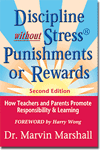|
 |
| Teachers.Net Gazette Vol.5 No.11 | November 2008 |
Subscribe for free home delivery |
|
Use Contingencies, Rather Than Consequences People do better when they feel good—not bad—so, use contingencies, rather than imposing consequences. Here’s the simple, but effective technique! | |
| by Dr. Marvin Marshall www.MarvinMarshall.com Regular contributor to the Gazette November 1, 2008 |
|
 What Bill Cosby’s character Dr. Huxtable learned about offering contingencies
Since people do better when they feel good—not bad— A simple way to send fewer negative communications and reduce resistance is to use contingencies, rather than consequences. The essence of a contingency is, “Yes, you may do that, as long as you first do this.” “Yes, you may ride in the boat, as long as you wear a life jacket.” Contingencies are so very effective because they promise with the positive—rather than threaten with the negative the way that imposed consequences do. Although consequences can be either positive or negative, when parents refer to “consequences,” they often think in terms of threats or punishments that are imposed. In contrast, “contingencies” paint positive pictures, empower, and are more effective. Contingencies prompt people to feel better, not worse. Test this on yourself. Reflect on which of the following you would rather hear:
An approach that relies on consequences such as, “Do this—or else!” prompts negative feelings. It threatens with pain or discomfort if the young person fails to comply with the demand. Such an approach also puts the responsibility of enforcement on the parent. Contingencies, on the other hand, place the responsibility on the young person—where it belongs. Suppose your daughter would like to visit her friend on a school night. You would like her homework to be completed first. When she asks, “Can I go to Tracy’s house?” your habitual response might be, “Not until you finish your assignments.” In contrast, if you respond with positivity, your response might sound something like, “Certainly, as soon as your homework is finished.” Or better yet, “As soon as you are satisfied with the quality of your work.” Two critical components for raising responsibility are at work here. In the positive statements, the responsibility for completing the home assignments is clearly on the young person. In addition, the parent has conveyed a message of trust and confidence—not only by allowing the daughter to visit with her friend but also in having her approve the quality of her efforts on the home assignments. As Booker T. Washington once said: “Few things help an individual more than to place responsibility upon him and to let him know that you trust him.” Contingencies do just that. Contingencies can be used with young people of any age to encourage cooperation and to build responsibility. For example, saying to a young child, “As soon as your toys are put away, we can go to the park,” sounds so much better and works much faster than, “We’re not going to the park until you put away your toys.” In the preceding examples, the responses are stated using empowering contingencies, rather than disempowering consequences. The girl is more motivated to complete her home assignments so she can visit her friend and the young child is induced to put away the toys in order to go to the park. Joy, a teacher who uses this strategy both at home and school, related the following experience of using a contingency with her teenage daughter, who, as Joy put it, “always tries to get away with doing the least possible around the house.” Tonight I told her, “Of course you may go out with your boyfriend—once the dishes are washed and put away.” Fifteen minutes later, not only were the dishes put away, but the floor was also swept and the stove and countertops were clean! An example of the difference between a consequence and a contingency was illustrated beautifully on the old television sitcom featuring Bill Cosby playing the role of Dr. Cliff Huxtable. Dr. Huxtable was sitting at the dinner table with Rudy, his youngest daughter. He would not let Rudy leave the table until she had eaten all her dinner. Rudy refused to finish the food on her plate. The father gave her a choice of finishing her dinner and leaving the table or remaining at the dinner table until she did finish. Still she refused to eat, whereupon the father went on and on about another 5-year-old who would not finish her dinner—whose friends all graduated from elementary school, went to middle school, graduated from high school, and then went off to college while the girl remained at the dinner table still refusing to finish her dinner. Rudy was not impressed; she still would not finish her meal. Dr. Huxtable had given his daughter what amounted to a consequence: finish your dinner or stay at the table. Denise, on the other hand, offered Rudy a contingency. Too often, we say to young people, “Eat your Brussels sprouts or else” and then can't understand why they are not motivated. Imposed consequences do not change the way a person wants to behave—and thus do nothing to promote responsibility or self-discipline. The old adage reminds us, "A person convinced against his will remains of the same opinion still.” It is important to remember that each time you threaten with a consequence, you are sending a message of distrust and low expectation. As with other forms of coercion, imposed consequences invite reluctance, resistance, resentment, and can incite rebellion and even retaliation. In addition, they create stress for everyone envolved. They rob adults of joy while also robbing children of opportunities to become more responsible. Of course, there are times when imposed consequences are necessary, but there is a positive and noncoercive way to use them. We can see how to discipline effectively by eliciting consequences in a positive way when we discuss the Raise Responsibility System at http://www.marvinmarshall.com/rrsystem.htm Copyright © 2008 Marvin Marshall Additional information is available at www.MarvinMarshall.com
| |
|


 His approach is the only system that is proactive, totally noncoercive, and does not use external manipulatives or threats. He INDUCES students to WANT to act responsibly and WANT to put forth effort to learn.
His approach is the only system that is proactive, totally noncoercive, and does not use external manipulatives or threats. He INDUCES students to WANT to act responsibly and WANT to put forth effort to learn.
